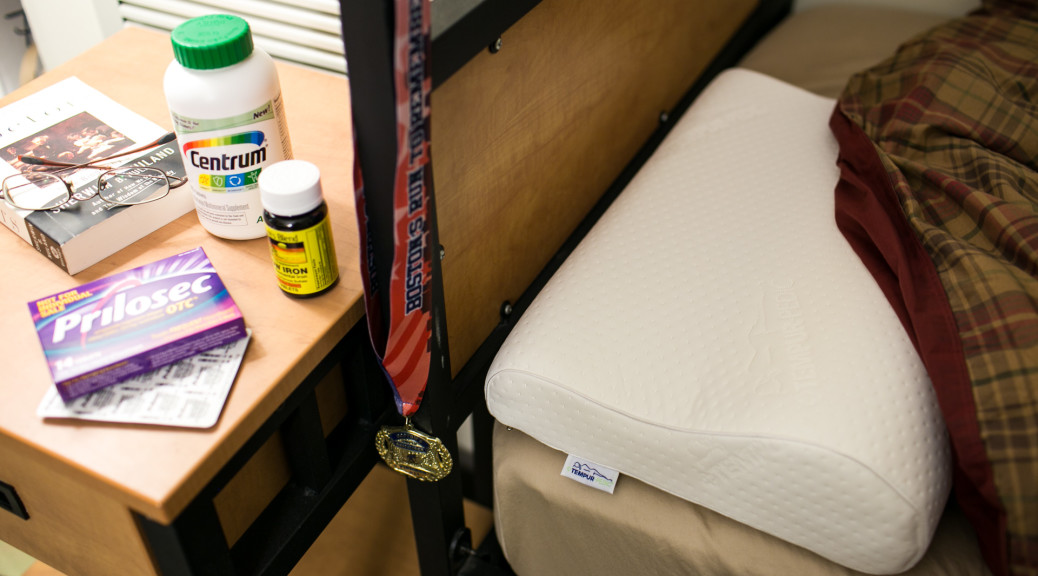How much am I willing to pay for a pillow? Turns out, a lot of money.
For the past nine years, I have slept without a pillow. This was both voluntary and convenient; I sleep on my back and believed that a flat sleeping surface facilitated a natural neck position, and I’ve moved eight times in eight years and was glad to not have a bulky pillow to babysit. On top of that, I would have had to wash the pillow and maintain its pillowcases and such. And a pillow costs like, what, $20?
Well, it turns out that not having a pillow costs much more than that. I have GERD, or gastroesophageal reflux disease. It’s basically recurrent heartburn, and it’s what my GI doctor found during the colonoscopy/endoscopy last month (see On Anaesthetics) while investigating my mysterious iron deficiency. GERD also not quite what I expected. Not only do I feel any of its typical symptoms, I don’t have any of the typical risk factors such as age, high-fat diets, gastric hernias, smoking, diabetes, or pregnancy. Yet, it’s there at the bottom of my esophagus, clear signs of acidic damage from the bubbling gastric pool below.
How did I get it? My dad immediately offered a suggestion: “say, do you think it might have to do with how you don’t sleep with a pillow?” My reaction: “shit, you’re right!”
The junction between the esophagus and the stomach doesn’t have a sphincter, a dedicated muscular ring to squeeze it shut (most junctions do). Instead, the gastroesophageal junction relies on gravity to keep the corrosive acid down in the stomach. Lying down soon after eating can let residual stomach contents slosh up to the less protected esophagus. Lying down all way actually puts the esophagus lower than the stomach (relatively anterior in the abdomen), which can let even the tiniest residual stomach acid to dribble out. Sleeping on my back with no pillow lets that damage happen for 6 hours every single day.
That’s why I am now the proud owner of a super fancy $100 Tempurpedic® memory foam pillow, complete with neck support! I got it on clearance and with a coupon for $40, but even at retail it would have been an economically sound purchase.
I distinctly remember seeing an ancient wooden pillow — which was basically a head cradle with an elaborately carved base — in a museum display and wondering who would ever be comfortable sleeping on that. I was too fixated on my affluent western notion of a pillow as a fluffy white decorative item that appears in large piles near hotel headboards. However, if this were any indication, pillows appear in virtually every culture around the world, and that can’t be coincidence. Elevating the neck while sleeping appears just as physiologically crucial to our species as sleeping under shelter, or wearing clothing or cooking food.
After my diagnosis, I wonder how naive I was to presume that I was better off without one. Inconvenience and distraction aside, I’m paying through my throat for my lack of pillow in a purely monetary sense. The copayments I’ve paid for the office visits, blood tests, and endoscopy have already amounted to $200. The iron pills and PPIs and multivitamins amounts to $20/month, which will be about $150 by the end of my treatment. Lucky for me that GERD is a low-impact low-cost disease to have…
Buying my pillow now doesn’t recuperate the $350 I’ve lost already, but just consider what potential costs it is saving me. $240/year for pills if my throat continues to bleed. $20/year for mints to battle back my bad breath and the nasty acidic taste in my mouth. $10/meal when I decide to buy smoothies because my throat hurts too much. Maybe a $1,000 hospital bill for when the ulcers get really bad. Or if I get esophageal adenocarcinoma, then $100,000/year * 20 years when I have to quit my job when they resect my esophagus and accidentally nick my voice box nerve.
Sure, I don’t presume that would happen to me, but even if there’s a 1 in 50,000 chance that that -$2M loss situation would happen, that’s still -$40 of theoretical risk for not owning a pillow. Thus, my pillow is still a cost-efficient health intervention. And that’s the basis of preventive medicine!
I’m quite frugal, but I spend more when protecting the valuable and vulnerable parts of my body. My contact lenses and solutions for my eyes, multiple pairs of gloves for my fragile fingers, and sturdy and springy shoes for my feet/ankles/knees/hips all earn generous budgets. Yes, this argument can be stretched to justify the purchase of almost anything, but at least it’s a good framework for responsible spending.
